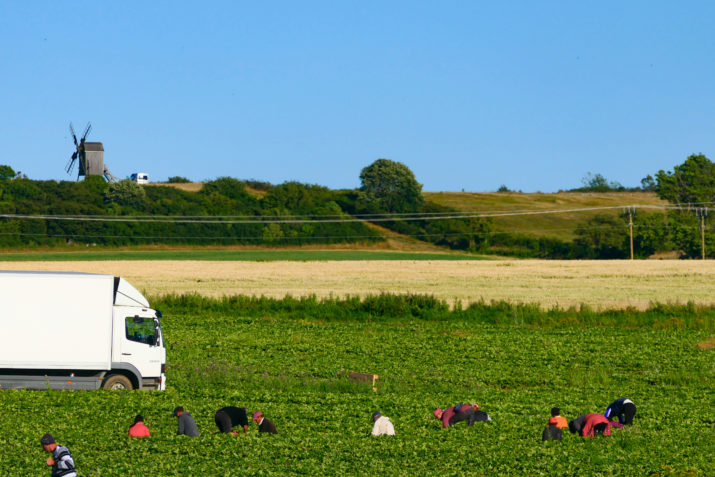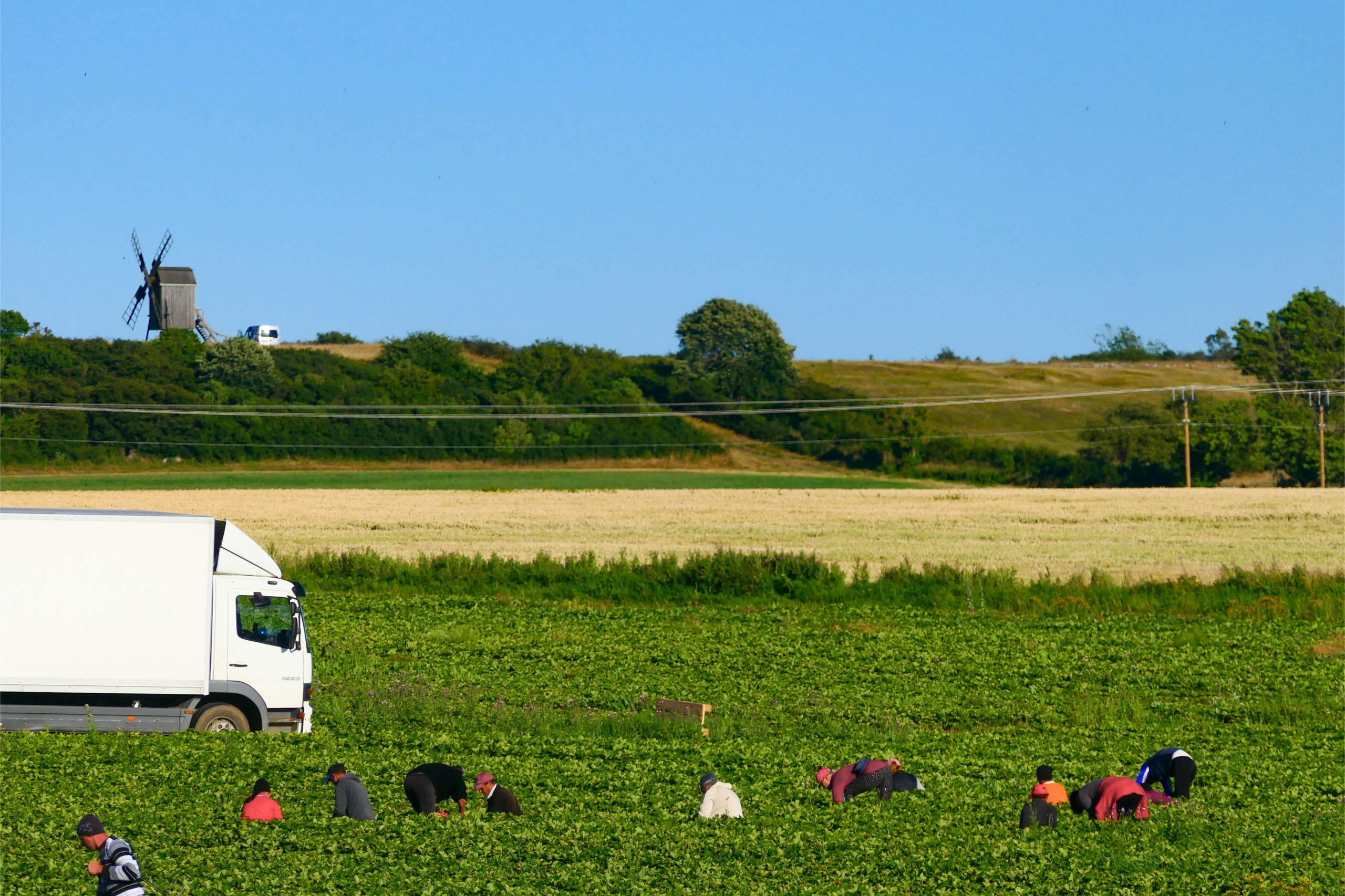

This is part of a series on the Novel Coronavirus (COVID-19) pandemic.
Earlier this spring, when Europe went into lockdown to limit the spread of COVID-19, when governments banned international travel even within the European Union, when the entire world stayed at home and cities were seemingly deserted, in Central and Eastern Europe, hundreds of thousands of people crowded airports and train stations, waiting for hours to board international charter flights. Exempt from the harshest restrictions, and exposed to the highest risks, these migrants continued to cross borders even at the peak of the pandemic to make a living and keep Europe’s economy afloat. Austria arranged special trains to bring in thousands of caretakers from Bulgaria, Croatia, and Romania. Germany flew in Polish, Romanian, and other Eastern European workers for its agriculture and meat industry. In a time of border closures and travel bans, how was this possible? Who takes responsibility for the impact of such exemptions on public health? The World Health Organization announced that COVID-19 will be around for years. Who protects Europe’s essential workers, as we brace for future pandemic waves?
In addition to the COVID-19 pandemic, Europe has been battling another major threat: the most severe food crisis in decades. This spring, since mid-March and early April, border closures within the European Union prevented Eastern European seasonal workers from traveling to France, Germany, Italy, Austria, and Spain to harvest crops. Italy predicted a shortage of one million agriculture workers; France needed 200,000 workers; Germany and the United Kingdom needed 400,000 seasonal workers each to prevent crops from rotting in the fields. Desperate to recruit, Western and Southern European governments negotiated with Eastern European countries to create exceptions that allow migrants to return.
Migrants have always been both essential to modern economies and objects of suspicion, but the Coronavirus pandemic has brought this tension to a head both in migrant-sending and migrant-receiving countries. On the one hand, non-migrants fear the potential for foreign contagion. On the other hand, migrants care for the elderly and the sick, babysit, and pick the produce that feeds a country. The case of Eastern European migrant workers in the EU captures the resulting dilemmas.
Consider Romania, the country with the highest number of intra-EU migrants. Before the outbreak, between 3 and 5 million Romanians worked abroad (Italy, Spain, Germany, Austria, the UK) in agriculture, construction, and caretaking. Many maintained a home in Romania, where they built houses, started businesses, and supported aging parents and small children with remittances. When COVID-19 hit Western and Southern Europe, many lost their jobs and decided to repatriate. Some carried the Coronavirus. “Imported cases” spread in Eastern Europe. In Poland, migrant workers fleeing from Germany, Italy, and the UK were among the first cases. In Romania, COVID-19 arrived from Italy in late February.
Romanian authorities adopted sweeping measures. All asymptomatic travelers from affected areas had to quarantine for fourteen days. Authorities put thousands in institutionalized quarantine (hotels near the migrants’ homes) after failure to self-isolate. The government equipped airports with thermal scanners, and mandated special lines for passengers from COVID19-affected areas. The mass return of migrant workers—over 1.5 million—worried non-migrants and officials. Journalists exposed migrants’ recklessness: some Coronavirus-contaminated returnees lied that they were returning from Germany or Austria (instead of Italy) in order to skip the long lines, formalities, and quarantine. They ended up spreading the disease in their communities, infecting and killing their parents.
In early March, the Romanian government banned public gatherings and ordered school closures. Some border crossing points were closed to focus on those with highest traffic. After low-cost airlines cancelled flights, migrants returned by bus or drove back. Overwhelmed authorities could not keep up as returning citizens waited in line for seven hours at the Western border. Unsurprisingly, protests broke out. In mid-March, President Klaus Iohannis instituted state of emergency for thirty days, and on March 24, a military ordinance mandated national lockdown. When the government banned flights and suspended all international road and train transportation, many crossed the border on foot.
More than 1.5 million Romanians repatriated. The result could have been a complete disaster. However, for all its flaws, Romania’s response to the pandemic was surprisingly successful. The result? 16,000 confirmed cases and 1,000 deaths in a population of 19.4 million.
But instead of reaching a simple happy ending, the story of Romanian (and Eastern European) migrants took a surprising twist. The same countries that expelled Romanian workers faced unprecedented workforce shortages. Without caretakers for children and aging parents, citizens could not work, and European economies could not reopen. With crops rotting in the fields, food shortages loomed. Despite unemployment rising to historic highs, Italians, Spaniards, Germans, Austrians, and Brits scorned the jobs that had opened up after Romanian workers left. Germans, who love white asparagus (spargel)and call it “the king of vegetables,” were in no rush to pick it.
Europe needed its essential workers. Western and Southern European countries reached out to Romania to find solutions. After negotiations, the military ordinance #7 that extended the national lockdown made an exception to allow charter flights to transport seasonal workers from Romania back to Western and Southern Europe. Since then, thousands have been leaving for Italy, Spain, Germany, Austria, and the UK every day.
While doctors, nurses, and delivery drivers draw public praise during the Coronavirus pandemic, essential migrant workers go unacknowledged. Eastern European farm workers and caretakers have allowed European economies to reopen; yet, they remain invisible. In Europe, dependence on migrant workers—in sending and receiving countries—has defined public policy responses to COVID-19.
In the short term, everybody wins. Destination countries prosper as migrants feed citizens and help reopen economies. Sending countries benefit from remittance money and reduced unemployment. Migrants can make a living and support families at a time when jobs are hard to find. However, in the long run, migrants’ homelands would be remiss to not anticipate the huge costs of quarantining and caring for returnees. On April 11, a fifty-seven-year-old Romanian agricultural worker was found dead in German Baden-Württemberg; he had caught COVID-19 while harvesting asparagus, reportedly asked to be taken to the hospital when he started having trouble breathing, but was ignored. Romanian farm workers have complained that they live in overcrowded facilities, lack protection equipment, have no onsite medical assistance, and are forced to work fourteen to sixteen hours a day. In June, Europe’s biggest slaughterhouse and meatpacking plant, Tönnies, located in Rheda-Wiedenbrück, North Rhine-Westphalia, Germany, became the largest European epicenter of Coronavirus spread. When hundreds of cases were confirmed, company officials rushed to blame migrants who make up the vast majority of employees at the plant. Union officials replied that Tönnies was trying to cover up an outbreak that catastrophic, exploitative, and unsanitary working and living conditions (crammed communal housing, no protective equipment, no social distancing etc.) had caused. After over 1550 workers tested positive, Germany imposed new lockdown measures in the region. 7,000 Romanian, Bulgarian, and Polish employees and their families were forced into quarantine in the crowded company-provided dormitories. A tall fence built around the slaughterhouse prevented workers from escaping, while police and other security officials were deployed to enforce the lockdown. These measures increased contagion risks, making it impossible for workers to social distance, buy protection equipment, and access medical care.
The effects of COVID-19 spread among migrants do not stop at the workplace or the destination country, of course. Instead, they diffuse and trace the map of transnational connections between migrant essential workers’ communities abroad and their countries of origin. While, initially, Central and Eastern European countries appeared to reap the fruits of their early-imposed lockdowns, currently the pandemic is ravaging the region. In late-spring early-summer, Romania experienced several spikes in the number of new cases. The phenomenon can be partially attributed to lack of compliance with social distancing, but there is also substantial evidence that these increases are linked to essential workers’ migration. In early August, there were over 5,600 Romanian citizens in other EU countries confirmed as infected with COVID-19, notably 1,891 in Italy, 570 in Spain, and 2,672 in Germany (the countries with high numbers of Romanian essential migrant workers). In comparison, there were only four Romanian citizens infected with Coronavirus in the United States, 18 in Greece, and 124 in France.
As historian Frank Snowden remarked, pandemics present a mirror in which humanity can see its face. Will Europe cooperate to care for its essential workers, or will they become a problem that Eastern Europe will have to confront alone? Balancing pandemic containment and economic reopening has defined the two dimensions of public policy response to COVID-19 in Central and Eastern Europe. On the one hand, governments in the region have cooperated with Western European counterparts to allow essential workers to return to Western and Southern European countries whose food security and economic reopening depend on migrant labor. On the other hand, Eastern European countries have been left to their own devices when it comes to treating returning migrants, limiting contagion from migrants to non-migrants, and—more generally—bearing the public health costs of Europe’s economic reopening. The Coronavirus outbreak exposes our profound economic dependence on migration, even in times of lockdown and border closure. It shows how deeply European prosperity has come to rely on freedom of movement and essential workers from Central and Eastern Europe. Hopefully, it will not also reveal what disasters can result from governments’ failures to cooperate.
Ruxandra Paul is Assistant Professor of Political Science at Amherst College, Massachusetts, in the United States. Her research agenda and teaching concentrate on international migration, European integration, citizenship, democracy and democratization, post-communist politics and societies, the impact of globalization on transnational rights, and cyberpolitics. She holds a PhD in Government from Harvard University, and received her B.A. (summa cum laude) in Political Science, and French Language & Literature from Williams College, Massachusetts.
Photo: Morbylanga, Oland, Sweden July 23, 2020 Migrant workers from Thailand and eastern Europe picking strawberries in a field | Shutterstock
Published on September 3, 2020.




